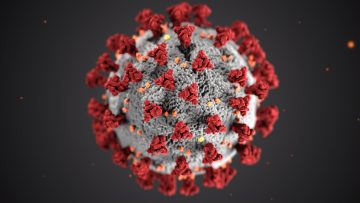 By Guillermo Caballero Silva, PhD Candidate, Strynadka Lab
By Guillermo Caballero Silva, PhD Candidate, Strynadka Lab
The rapid emergence and propagation of the novel coronavirus SARS-CoV-2 has prompted collaborations among scientist from diverse fields of research, all looking to understand and hopefully predict the course that COVID-19 is taking. One of these teams is composed of the Centre for Blood Research’s (CBR) own Dr. Natalie Strynadka, in addition to Dr. Robert Brunham, head of the Vaccine Research Laboratory at BC Centre for Disease Control (BC CDC), and Dr. Vikram Mulligan, co-founder of Menten AI and lead developer of prediction computational softwares. The overarching goal of this work is to the predict and identify potentially detrimental mutations in SARS-CoV-2 using a combination of artificial intelligence, sequence-based prediction algorithms, and atomic resolution structural biology.
In order to analyze the many single amino-acids mutations obtained from prediction software, it is necessary to elucidate and optimize alternative purification protocols that can produce large amounts of proteins. However, one of the most critical and often difficult steps in biochemistry is the production of pure and stable amounts of proteins, as these are often dependent on the type of expression system and methods used.
The project focuses on the Spike glycoprotein of SARS-CoV-2, a trimeric surface membrane protein that is responsible for viral attachment and entry. This critical event is mediated by the high affinity interaction between Spike’s protein receptor binding domain (RBD) and human angiotensin-converting enzyme 2 (ACE2) which, upon binding, allow membrane fusion between the virus and cells. RBD is not only the current target of multiple vaccine development projects but is also the target of recombinant expression assays in the Strynadka Lab.

An illustration that depicts the shape of a coronavirus, created by the Centers for Disease Control and Prevention (CDC). Image via Unsplash.
Recombinant expression and purification of RBD has been a topic of great interest due to the multiple potential applications that it can provide, such as vaccine development and high-throughput biochemical analysis. Conventional expression of RBD has largely been carried out in eukaryotic, mostly human cell lines due to the presence of two glycosylation sites at the periphery of this 195-amino-acid-long protein fragment. The nature and importance of the glycosylations in protein folding and receptor recognition are still a matter of great debate due to the lack of structural information available. By adopting a multi-prong strategy, the Strynadka Lab has been experimenting and optimizing the expression of RBD in both eukaryotic (mammalian, insect, and yeast cells) and prokaryotic (E. coli) systems. Production of mammalian proteins in E. coli has its own challenges and limitations, mainly due to the lack of machinery to properly fold and modify exogenous proteins. Some of these problems can be readily addressed by exploring and using many of the available molecular and biochemical resources developed specifically for bacterial recombinant expression and purification.
So far, this multi-faceted approach has resulted in the successful expression and purification of both RBD and ACE2 peptides in all eukaryotic system experiments as expected, but also in E. coli cells. However, further validation will be needed in order to confirm that the lack of glycosylations resulting from prokaryotic expression did not affect the folding or activity of peptides. Through the implementation and optimization of the expression conditions, as well as the hard work of the COVID-19 response team, we are now able to produce soluble and stable proteins for crystallization and X-ray crystallography. Now that the first hurdle has been passed, we will be able to focus on the development and production of RBD mutants that are predicted to increase and benefit the virulence and endurance of SARS-CoV-2. Ultimately, this will help us understand, predict, and prepare ourselves from any potential mutations that might arise in this virus that has already shaken the world enough.
Read more about the Strynadka Lab and the CBR’s work in combatting COVID-19:
- More on the Strynadka Lab’s work in predicting the evolution of COVID-19 to help manage future outbreaks
- How the Strynadka Lab is pursuing new COVID-19 drug treatments
- Hancock Lab: Using genomic methods to identify COVID-19 patients with a higher risk of developing life-threatening sepsis
- Overall Lab: Identifying protein targets of SARS-CoV proteases to gain insight into pathogenic mechanisms leading to COVID-19
- Kastrup Lab: Developing anticoagulant RNA-Based therapies for SARS-CoV-2 related thrombosis
- Dr. Karen Cheung helps develop low-cost, on-the-go COVID-19 screening technology with the ecoMine COVID-19 Screening Project


